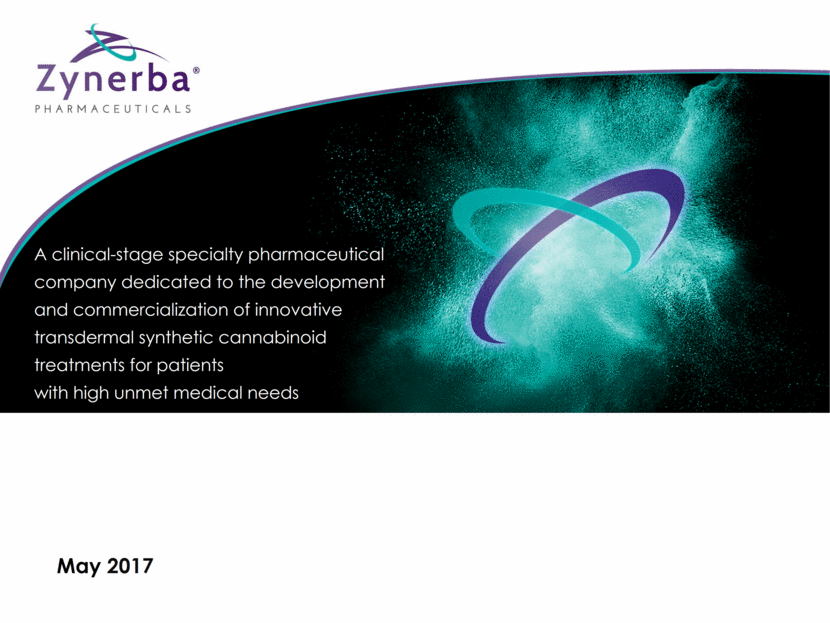Attached files
| file | filename |
|---|---|
| 8-K - 8-K - Zynerba Pharmaceuticals, Inc. | a17-12087_18k.htm |
Exhibit 99.1
May 2017 A clinical-stage specialty pharmaceutical company dedicated to the development and commercialization of innovative transdermal synthetic cannabinoid treatments for patients with high unmet medical needs
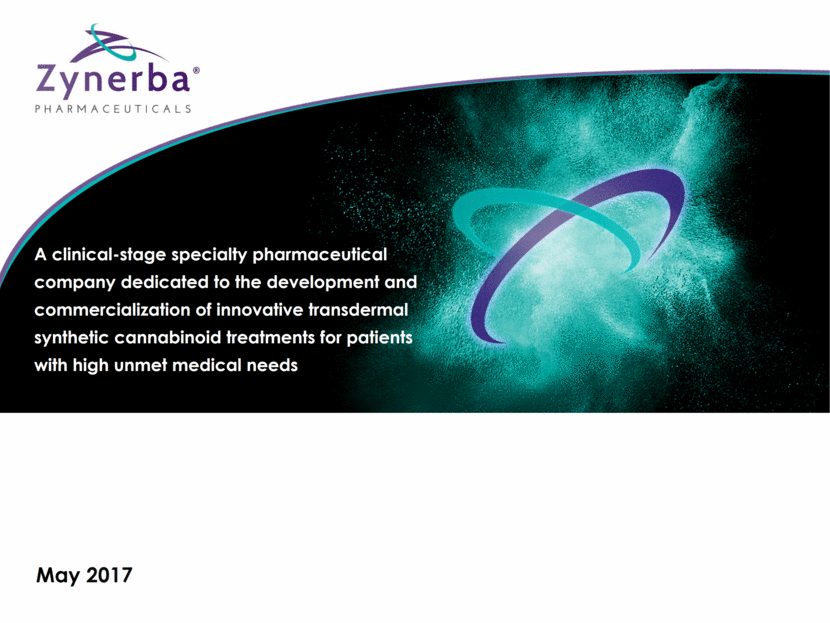
Disclaimer The statements in this presentation may include forward-looking statements within the meaning of Section 27A of the Securities Act of 1933, as amended, and Section 21E of the Securities Exchange Act of 1934, as amended. These statements, among other things relate to the future operations, opportunities or financial performance of Zynerba Pharmaceuticals, Inc. We may, in some cases, use terms such as “predicts,” “believes,” “potential,” “proposed,” “continue,” “estimates,” “anticipates,” “expects,” “plans,” “intends,” “may,” “could,” “might,” “will,” “should” or other words that convey uncertainty of future events or outcomes to identify these forward-looking statements. Such statements are subject to numerous important factors, risks and uncertainties that may cause actual events or results to differ materially from the Company’s current expectations. These and other risks are described in our filings with the Securities and Exchange Commission, available at www.sec.gov. Any forward-looking statements that the Company makes in this presentation speak only as of the date of this PRESENTATION. The Company assumes no obligation to update forward-looking statements whether as a result of new information, future events or otherwise, after the date of this presentation. 2 © 2017 Zynerba Pharmaceuticals, Inc. All rights reserved. Zynerba is a registered trademark of Zynerba Pharmaceuticals, Inc. All other trademarks and registered trademarks are property of their respective owners.
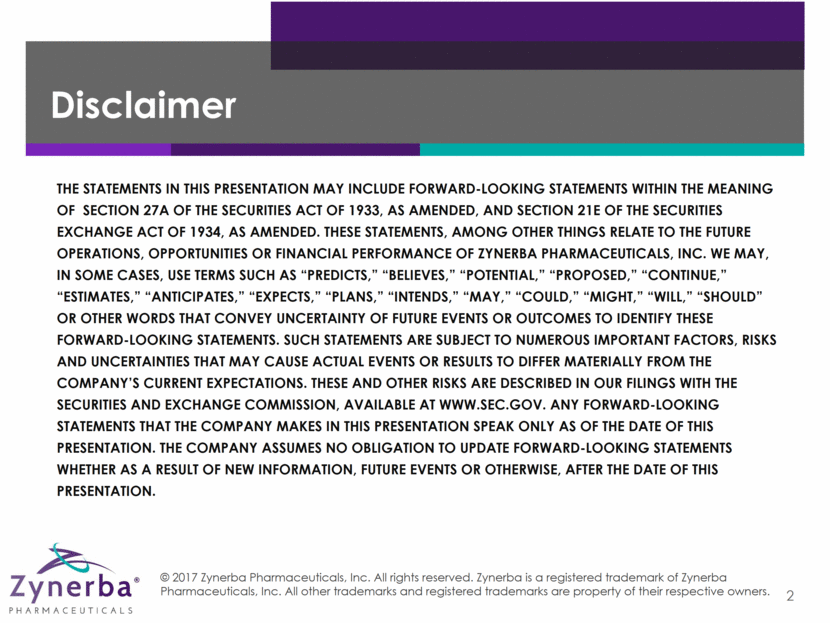
Enrollment Complete for Two Phase 2 Trials Top Line Results Expected in July/August 2017 3 Osteoarthritis — STOP Epilepsy — STAR 1 188 patients randomized (target was 180) 320 patients randomized (target was 300) * As of April 24, 2017
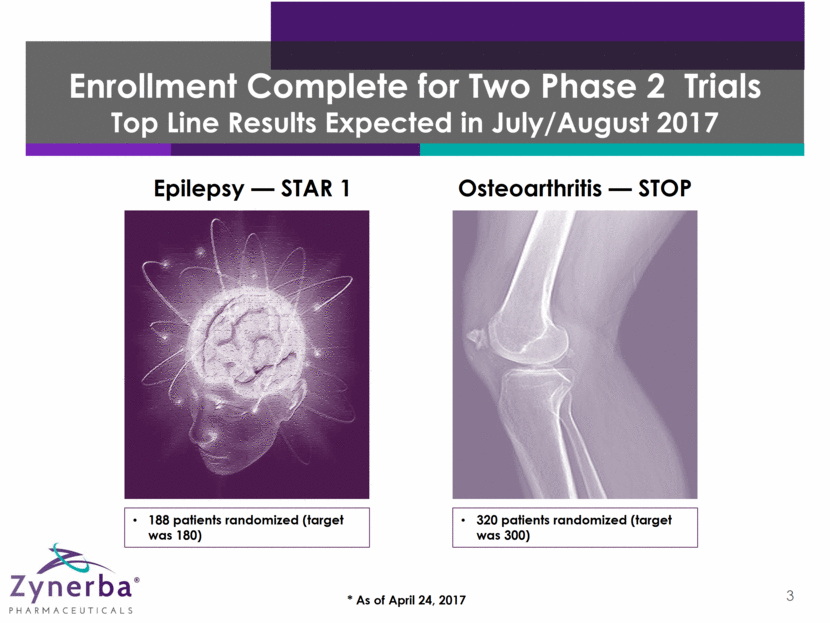
Company Highlights 4 A clinical-stage specialty pharmaceutical company pioneering the development and commercialization of patent-protected synthetic cannabinoid therapeutics for transdermal delivery Experienced team with deep expertise and proven track record of success in CNS and pain drug development and commercialization, as well as patch and gel transdermal deliveries, such as Testim® and Zecuity® Global ownership of two proprietary product candidates intended to treat diseases with significant unmet medical need and market potential ZYN002 – CBD Gel: epilepsy, osteoarthritis and fragile X syndrome ZYN001 – THC Pro-Drug Patch: fibromyalgia and peripheral neuropathic pain No royalty obligations owed on either product candidate Proforma cash at 12/31/2016 including proceeds from the Q1 2017 secondary offering ~ $85.3 million; expected runway into 2019 Enrollment complete in STAR 1 (epilepsy) and STOP (OA) trials; on track to deliver top-line results in July/August timeframe
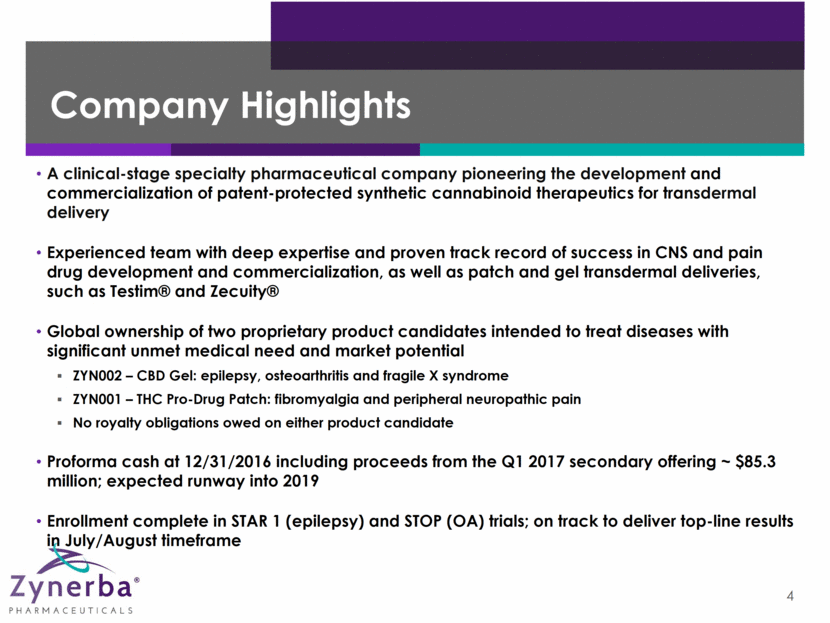
2017 – A Transformational Year Ahead with Multiple Near-term Milestones Expected from Robust Pipeline 5 ZYN002 patent protected through 2030 ZYN001 patent protected through 2031 Product Candidate Indication Preclinical Phase 1 Phase 2 Next Milestones ZYN001 – THC Pro-Drug Patch ZYN002 – CBD Gel Epilepsy in Adults with Focal Seizures Osteoarthritis Fragile X Syndrome (US FDA Orphan Drug Designation) Fibromyalgia Peripheral Neuropathic Pain Phase 2 Results July/August 2017 Phase 2 Results July/August 2017 Phase 2 Results Q3 2017 Phase 1 Initiation 1H 2017 Phase 2 Initiation 2H 2017
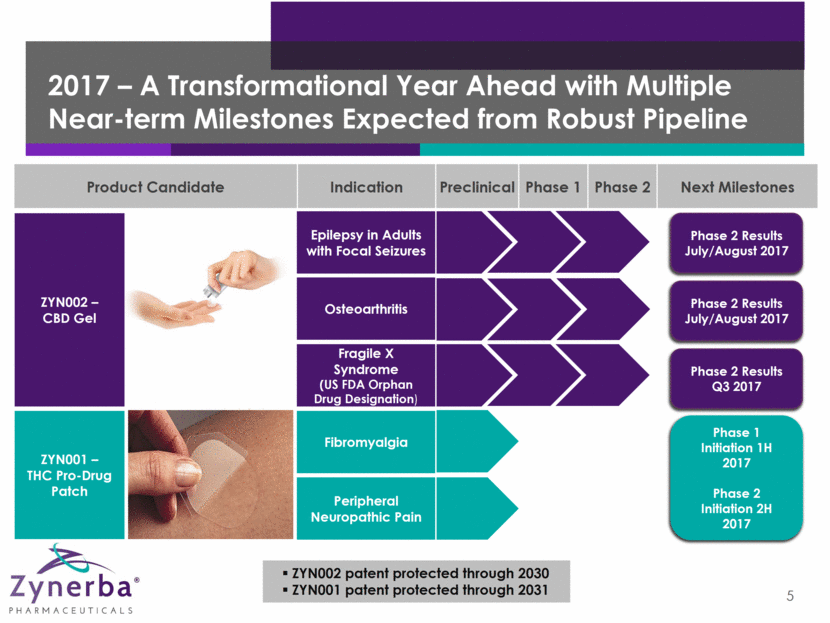
Why Zynerba is a Compelling Investment Opportunity in the High-Growth Cannabinoid Space 6 We believe CBD gel for focal seizures is a significantly de-risked lead candidate Reliable animal models show efficacy of CBD in epilepsy Third party studies have shown activity of CBD in reducing focal seizures STAR 1 trial is well powered to show clinical benefit versus placebo Zynerba’s transdermal approach has significant benefits Patent protection Synthetic manufacturing process can be scaled for large volume markets Attractive COGS and no royalty obligations should result in high gross margins Consistent, controlled blood levels of drug and potentially a better safety profile than oral formulations Focused on valuable unmet medical need markets ~ 1.5 million adult epilepsy patients in the US with focal seizures; ~ 31 million OA patients; ~ 6 million Fibromyalgia patients; ~15 million PNP patients and Orphan designation for Fragile X Syndrome* Significant clinical progress anticipated in the near term * Data per Decision Resources, Data Monitor, CDC, American Epilepsy Society and The Fragile X Society
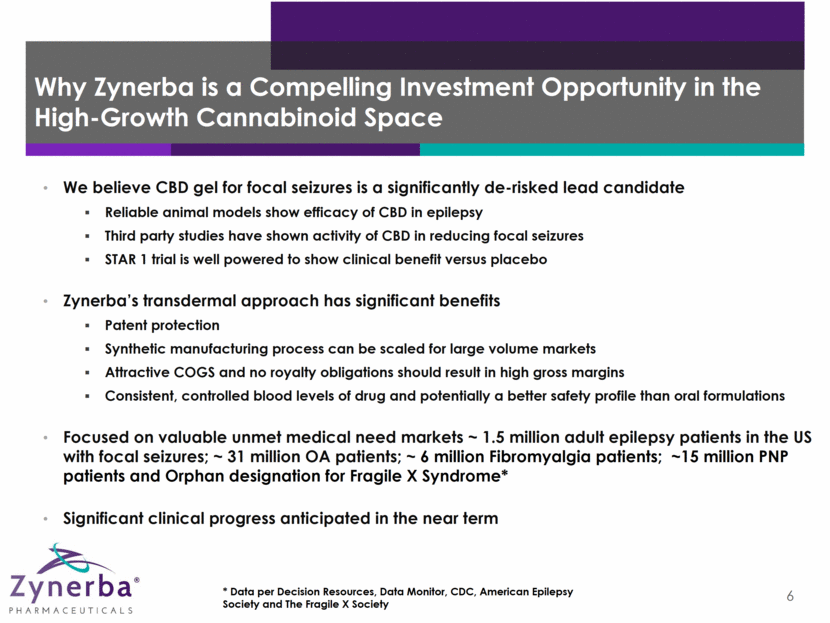
Breadth of Therapeutic Opportunities 7 Cannabinoids interact with specific receptors throughout the body to produce pharmacologic effects, mostly in the CNS and immune system. Δ9-tetrahydrocannabinol (Δ9-THC) Cannabidiol (CBD) Possible indications Fibromyalgia Neuropathic Pain Appetite Nausea and vomiting Sleep Spasticity Possible indications Epilepsy Osteoarthritis Fragile X Syndrome Anxiety Addiction Cognition Memory Neuroprotection Sleep Tumors
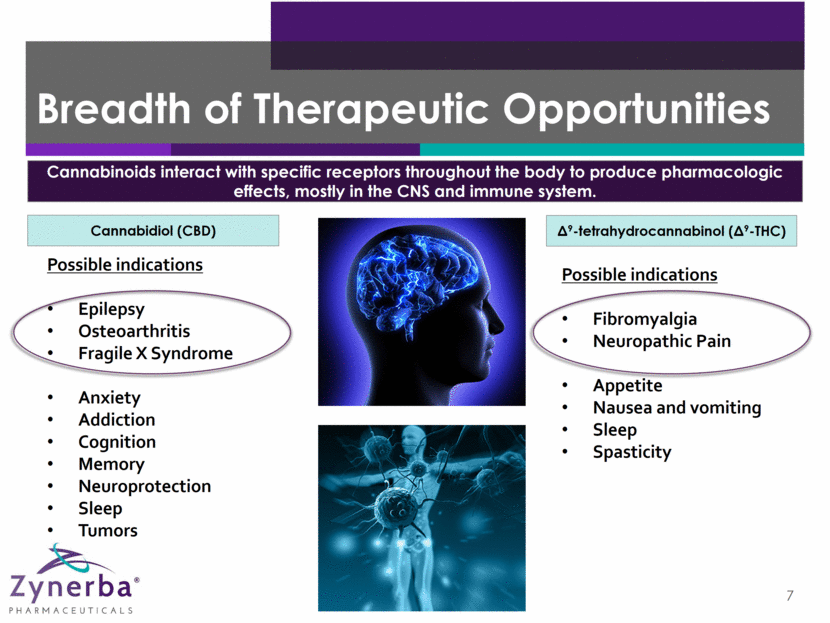
ZYN002 – CBD Gel First and only patent-protected permeation-enhanced synthetic cannabidiol gel formulated for transdermal delivery The permeation enhancer in ZYN002 increases the delivery of CBD through the layers of the epidermis and into the circulatory system 8 CBD Delivery
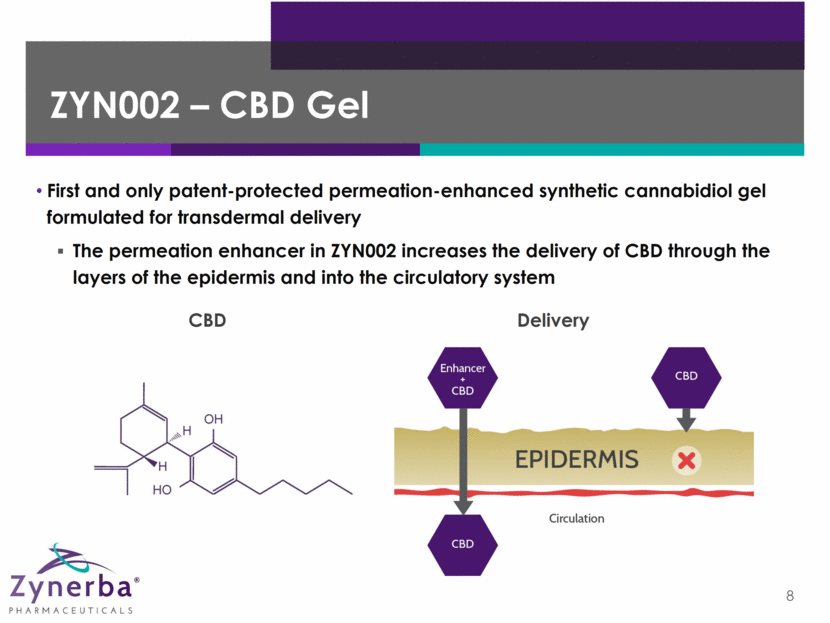
Transdermal ZYN002 vs. Oral CBD 9 Potential Benefits of Transdermal ZYN002 vs. Oral CBD More consistent, controlled and sustained plasma level Avoids first-pass metabolism in the liver Fewer drug-drug interactions Avoids the GI tract Very low incidence of gastrointestinal events Avoids degradation of CBD to THC Lower incidence of negative psychoactive effects
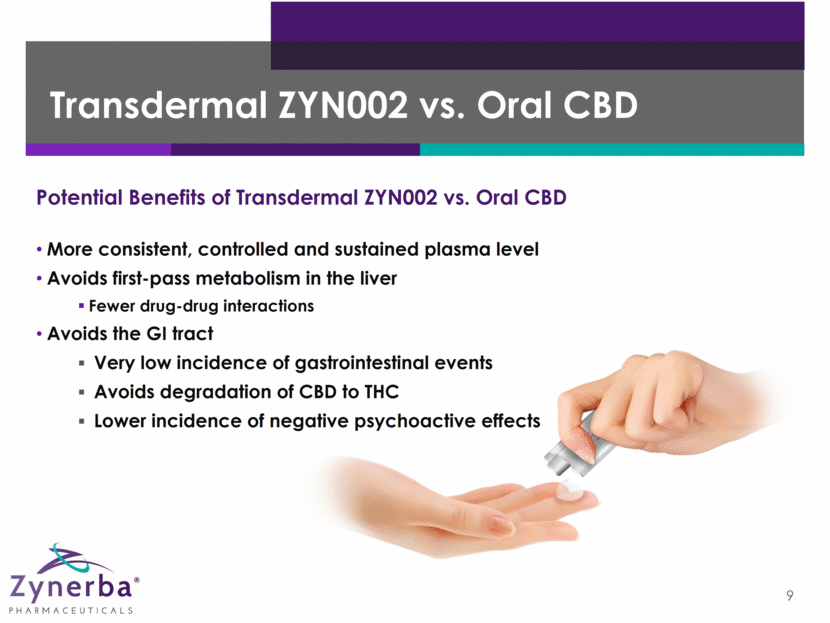
Transdermal CBD Avoids Degradation of CBD to THC 10 In Vitro Study ZYN002 avoids the GI tract, maintains CBD at physiological pH and prevents degradation of CBD to THC CBD degraded to THC in simulated gastric fluid May lead to increased psychoactive effects from THC Study data (Merrick et al.) published in Cannabis and Cannabinoid Research Δ8-tetrahydrocannabinol (Δ8-THC) Δ9-tetrahydrocannabinol (Δ9-THC) Cannabidiol (CBD) 0.1M HCl 0.1M HCl
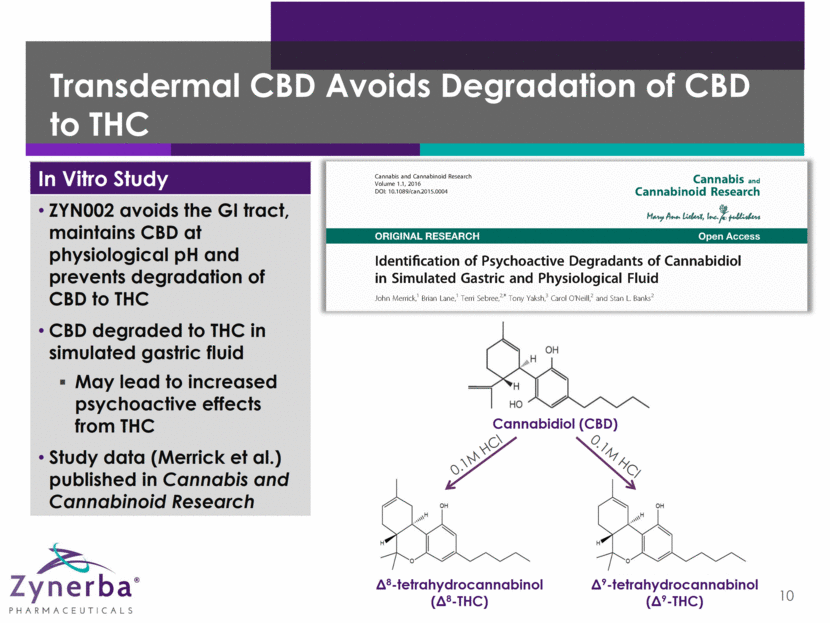
Trials 1 day, 7 day, and 14 day trials Subjects 98 healthy volunteers (n= 70 ZYN002; n= 28 placebo) and 22 epilepsy patients (n=16 ZYN002; n=6 placebo) Dose Daily doses levels – 50 to 504 mg CBD in 1%, 2.5% and 4.2% concentrations Safety & Tolerability ZYN002 was safe and well-tolerated at all dose levels and concentrations Transdermal application well-tolerated with minimal erythema No somnolence or fatigue reported Very low incidence of GI events observed Adverse events with ZYN002 in healthy volunteers and epilepsy patients were similar to placebo Pharmacokinetics Favorable CBD pharmacokinetic properties, no differences between healthy volunteers and epilepsy patients CBD plasma concentrations are dose dependent and at steady state do not fluctuate No THC detected in plasma or urine Cognition/Mood Demonstrated no impairment in cognitive function based on Trail Making, Divided Attention, & PASAT No changes in mood as assessed by IDAS and PANAS ZYN002 Phase 1 Results 11
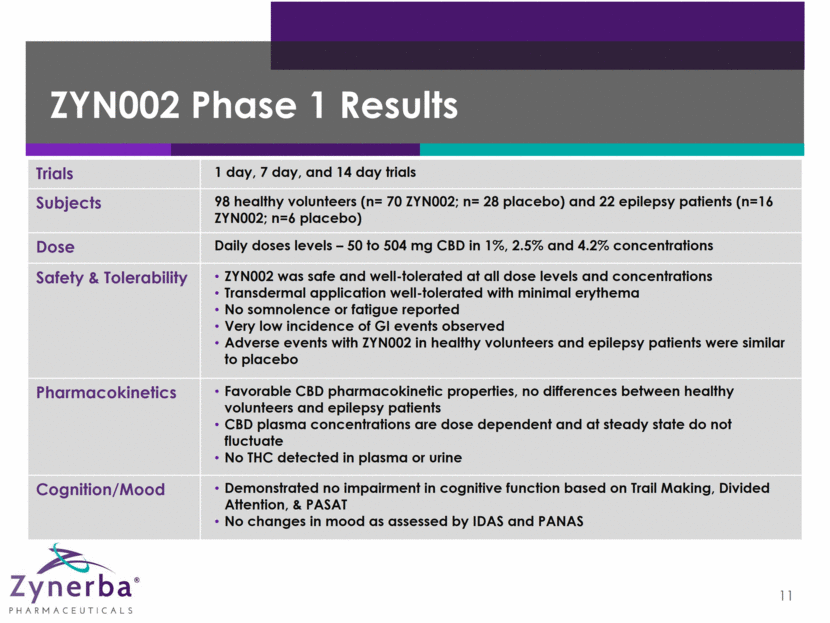
Why Are We Studying CBD in Epilepsy in Adults? 12 * Data per CDC and American Epilepsy Society CBD is effective in multiple animal models of epilepsy, which are highly predictive of efficacy in humans Kindling and maximal electroshock (models for focal and generalized seizures) Audiogenic, penicillin, pentylenetetrazole and pilocarpine Proven effective in reducing seizures in children and adults in third party trials Dravet syndrome, Lennox-Gastaut syndrome and focal seizures Size of market in the U.S. is substantial ~ 2.4 million adults with epilepsy in the US & ~ 1.5 million suffer from focal seizures*
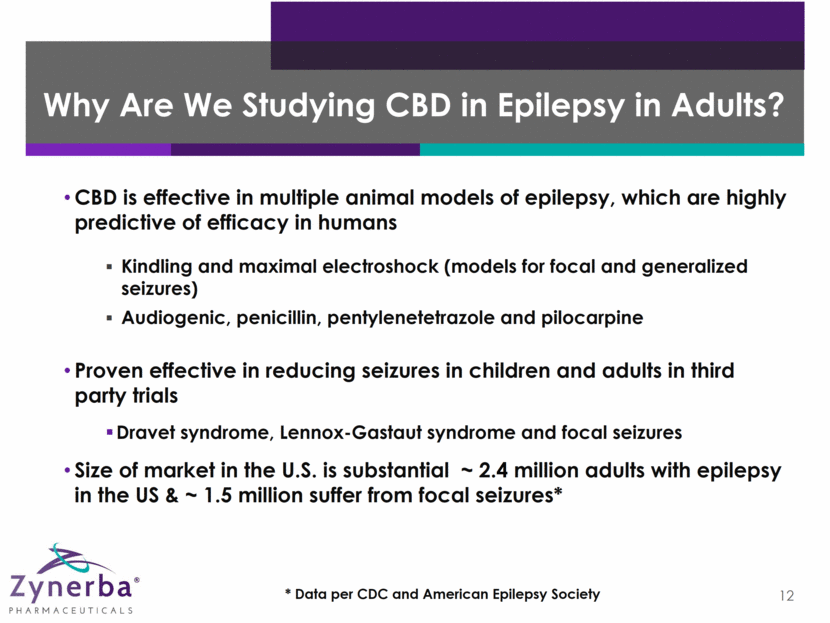
ZYN002 Should Effectively Treat Focal Seizures in Refractory Epilepsy Based on Other CBD Trials 13 Lennox-Gastaut Syndrome Dravet Syndrome Refractory Epilepsy with Focal Seizures Type of Trial 2 Double Blind Placebo Controlled (3rd Party) Double Blind Placebo Controlled (3rd Party) STAR 1 and 2 – Underway Patient Age 2 – 55 years old 2 – 18 years old 18 – 70 years old Brain Localization Multi-Foci Multi-Foci One or More Foci Seizure Type(s) Focal Tonic-clonic Atonic Focal Tonic-clonic Myoclonic Absence Atonic Focal Focal seizures that generalize to tonic-clonic Post-hoc analysis of a third-party open-label trial with oral botanical CBD in refractory epilepsy showed patients with focal seizures had a 55% reduction in seizures
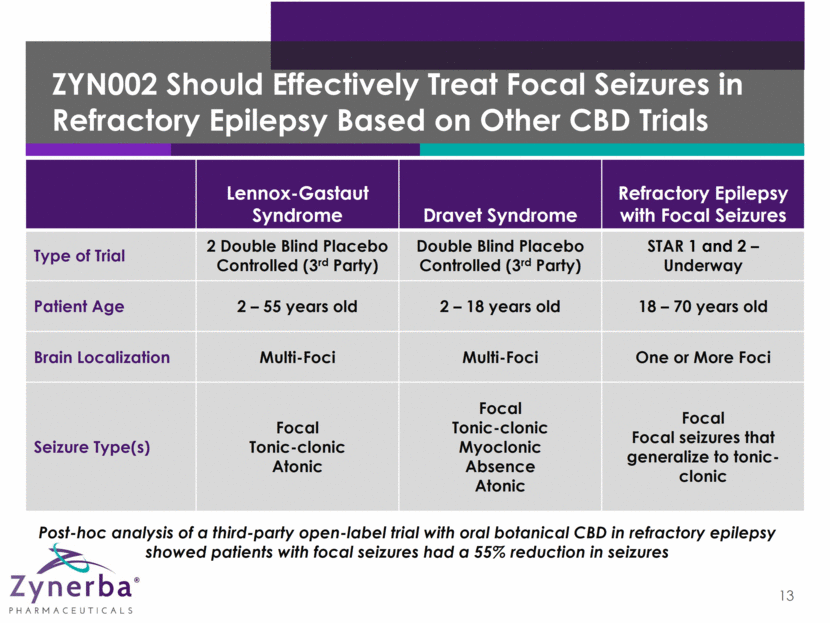
Epilepsy Phase 2 Clinical Trial Top Line Results Expected in July/August 2017 14 ZYN002 High-Dose CBD 195 mg* ZYN002 Low-Dose CBD 97.5 mg* Placebo Baseline Assess seizure frequency/type Open-Label Extension Synthetic Transdermal CAnnabidiol for the TReatment of Epilepsy *In 4.2% gel ZYN002 High-Dose CBD 195 mg* ZYN002 Low-Dose CBD 97.5 mg* STAR 2 Trial STAR 1 Trial As needed, dose reduced to: BID for 12 months BID for 12 weeks 8 weeks Randomized (1:1:1), double-blind, placebo-controlled - 188 patients randomized
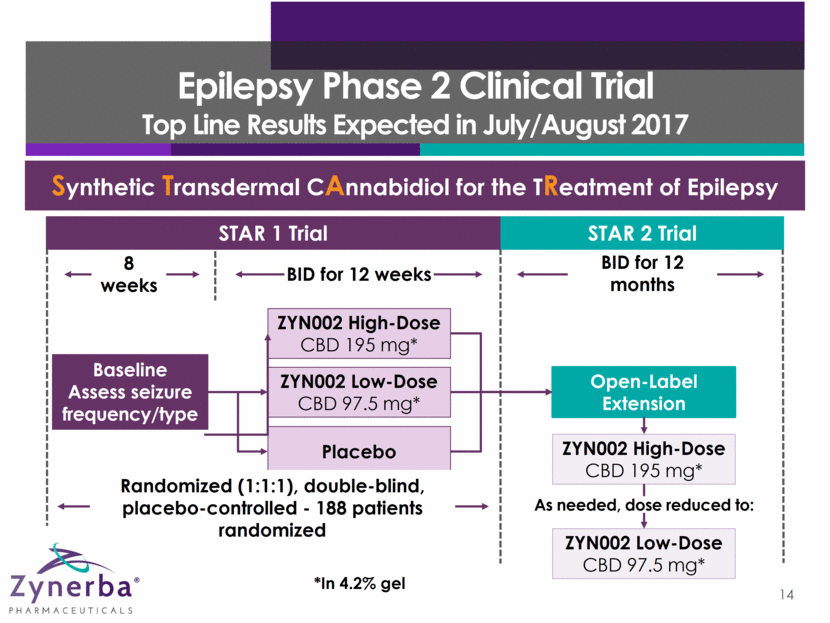
STAR 1 Efficacy Endpoints 15 Primary Endpoint: Median reduction in seizure frequency per 28-day period comparing baseline with the treatment period via daily seizure diary Secondary Endpoints Proportion of patients with ≥50% reduction from baseline in seizure frequency Percent change from baseline in seizure frequency Change from baseline in seizure frequency Seizure-free days 100% seizure-free
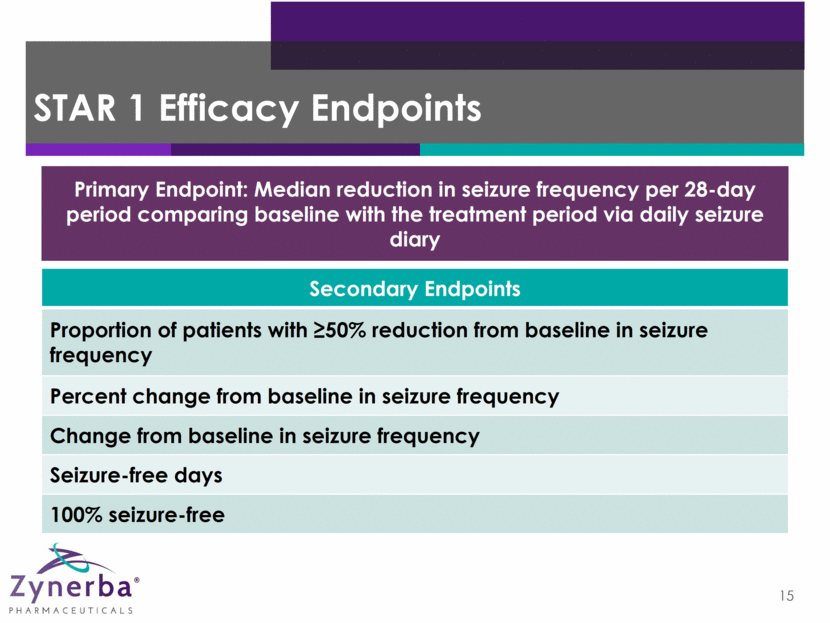
16 STAR 1 Baseline Information* Anti-Epileptic Drug Patients Anti-Epileptic Drug Patients Levetiracetam (Keppra) 72 Zonisamide (Zonegran) 20 Carbamazepine (Tegretol) 67 Perampanel (Fycompa) 16 Lamotrigine (Lamictal) 53 Clonazepam (Klonopin) 15 Lacosamide (Vimpat) 44 Oxcarbazepine (Trileptal) 13 Valproate (Depakote) 34 Phenytoin (Dilantin) 12 Topiramate (Topamax) 24 Phenobarbitone (Phenobarbital) 3 AED Use Average=2.5 AEDs Median=3.0 AEDs Median Seizure Frequency† 10.8 (3-335) †Median Monthly *As of 20 Mar 2017
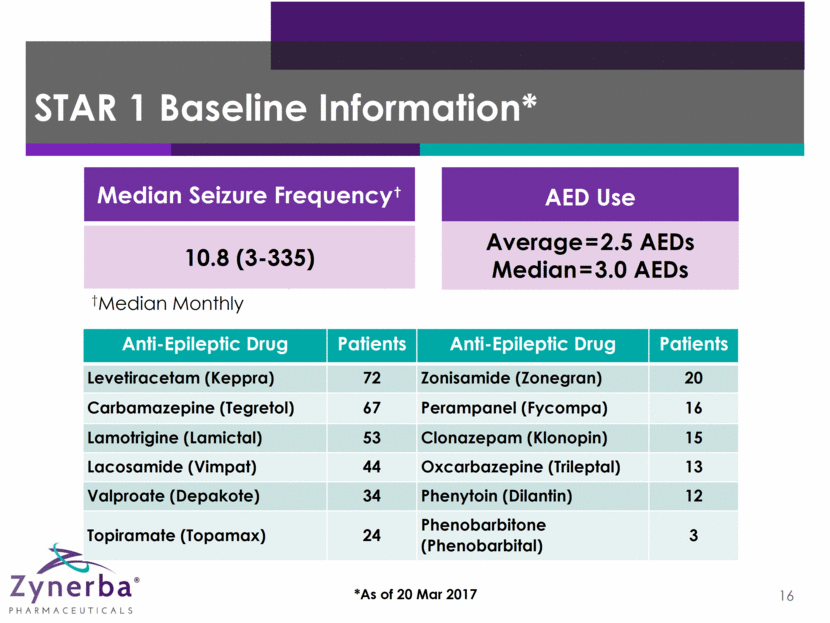
17 STAR 1 & STAR 2 Enrollment Status* Patients n Screened 224 Randomized 188 Still in Baseline 0 Completed STAR 1 139 Enrolled into STAR 2 135 * As of April 24, 2017
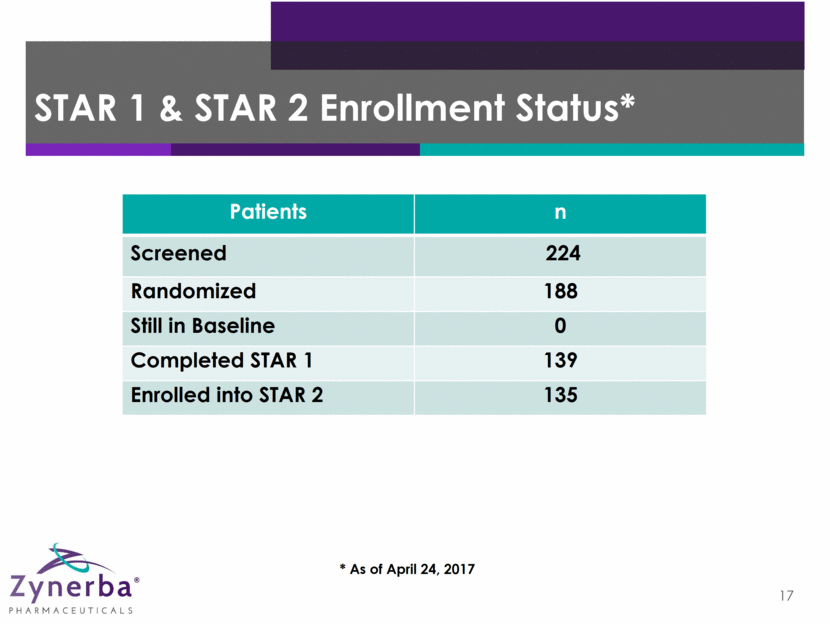
Why ZYN002 in Osteoarthritis? 18 CBD modulates the vanilloid TRPV1 receptor which mediates antinociceptive and anti-inflammatory effects Mono-arthritic rat model provides proof of concept* ZYN002 was applied for four days after inducing arthritis in rats Significant reductions in: Swelling of knee joints Immune cell infiltration Spontaneous pain rating scores Dose-dependent reduction of pro-inflammatory markers (CD11b/c, CGRP, TNF) CBD plasma concentration of 20 – 40 ng/mL provided optimal efficacy ~31 million osteoarthritis sufferers on prescription drugs in the US** * Hammell DC et al. Eur J Pain. 2015 doi:10.1002/ejp.818:1-13. ** Data per Data Monitor.
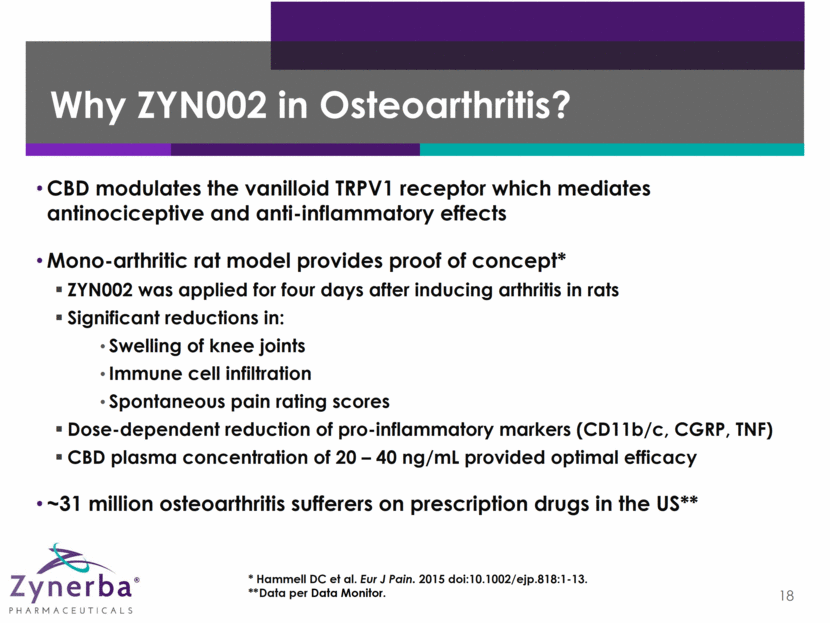
Osteoarthritis Phase 2 Clinical Trial – STOP Top Line Results Expected in July/August 2017 19 Synthetic Transdermal Cannabidiol for Treatment of Knee Pain due to Osteoarthritis ZYN002 High-Dose: CBD 250 mg* ZYN002 Low-Dose: CBD 125 mg* Placebo Washout Baseline 1 week Every 12 hours for 12 weeks 7-10 days *In 4.2% gel Randomized (1:1:1), double-blind, placebo-controlled –320 patients randomized
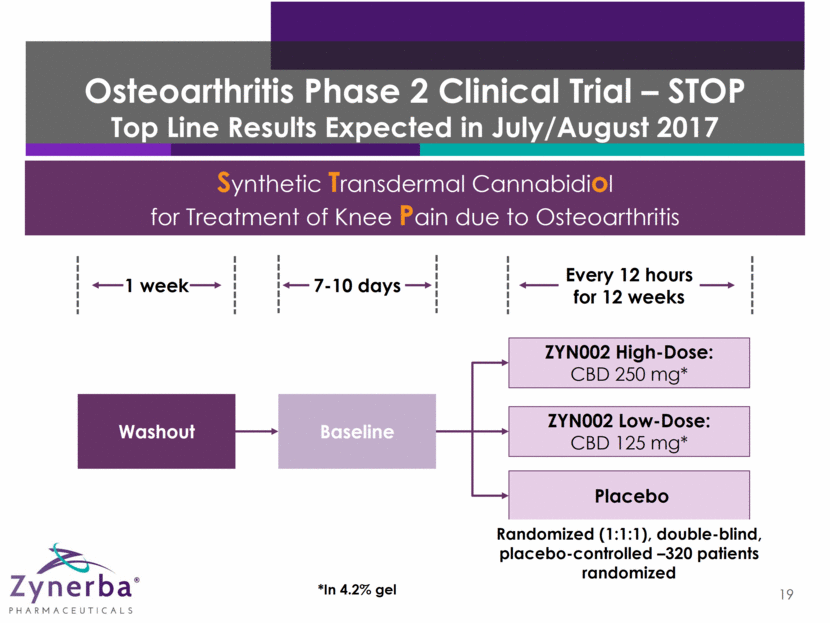
STOP Efficacy Endpoints 20 Primary Endpoint: Change from baseline in the weekly mean of the 24-hour average worst pain score at Week 12 Secondary Endpoints Assessments Change from baseline in the WOMAC Pain, Stiffness, and Physical Function Subscales Weeks 4, 8, 12 Responder rate based on ≥30% reduction in worst pain severity Weeks 4, 8, 12 Responder rate based on ≥50% reduction in worst pain severity Weeks 4, 8, 12 Change from baseline in the weekly mean of the 24-hour average worst pain score Weeks 4, 8 Percentage of participants using rescue medication Over 12 weeks Physician assessment of presence of joint effusion Over 12 weeks
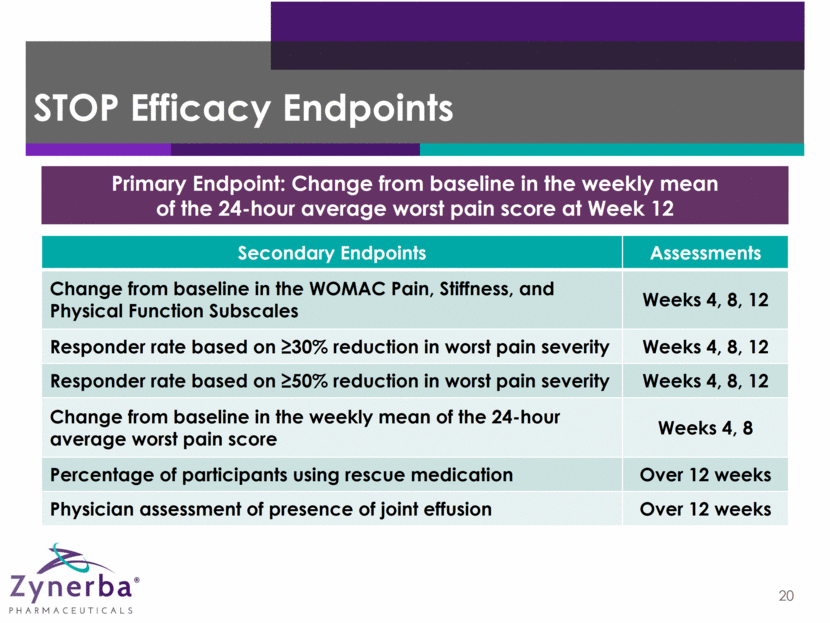
21 STOP Enrollment Status and Baseline Information Worst Knee Pain Score** (During Baseline) Mean=6.8 *As of 24 March 2017 **As of 20 March 2017 Patients n* Screened 418 Randomized 320 Still in Baseline 0
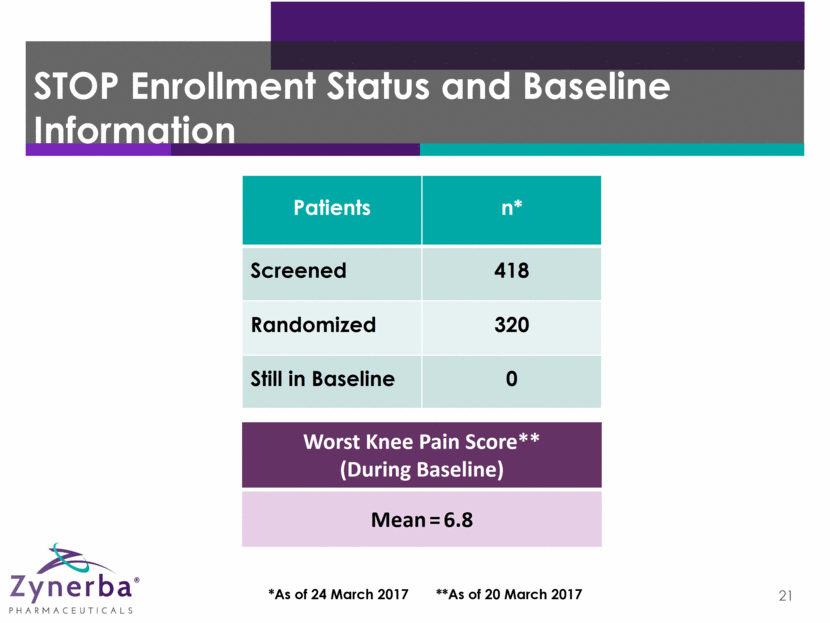
What is Fragile X Syndrome? 22 Fragile X Syndrome Autism spectrum disorder Most common inherited intellectual disability Caused by a mutation in the Fragile X Mental Retardation gene located on the X chromosome Leads to dysregulation of the endocannabinoid pathway including the reduction in endogenous cannabinoids (2-AG and anandamide) Negatively affects synaptic function, plasticity and neuronal connections Results in a spectrum of intellectual disabilities, social anxiety, memory problems
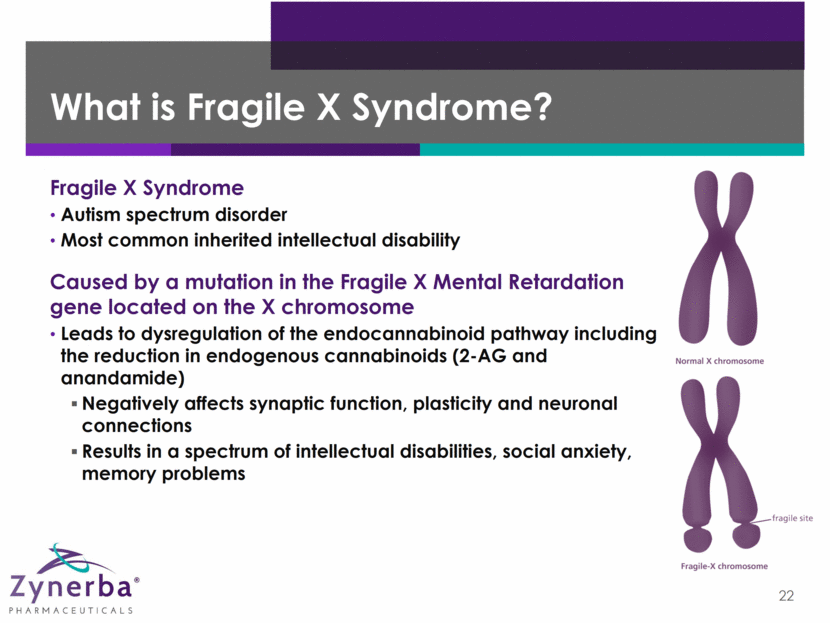
Why ZYN002 in Fragile X Syndrome? CBD may effectively treat Fragile X syndrome In mouse knock-out model, inhibition of the metabolism of 2-AG improves Fragile X syndrome symptoms CBD inhibits the metabolism of anandamide and 2-AG increasing availability of these cannabinoids CBD has strong anxiolytic properties ~ 71,000 patients in the US* FDA granted orphan drug designation for ZYN002 for Fragile X syndrome – may provide fastest pathway to approval 23 * Data per Fragile X Society
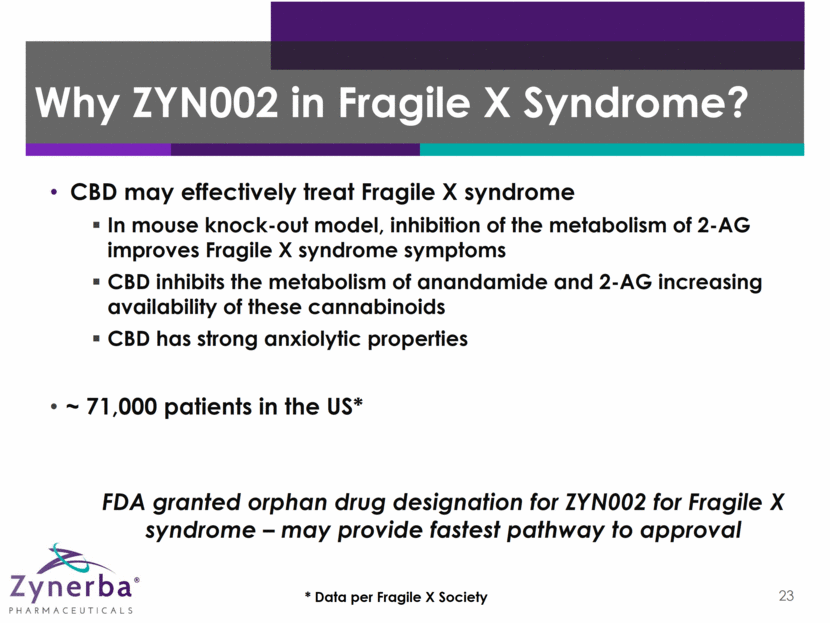
Fragile X Phase 2 Clinical Trial – FAB – C Top Line Results Expected in 3Q17 24 Maintenance Dosing initiated at CBD 50 mg Daily; may be titrated up to 250 mg* Daily Screening Titration Weeks 6 to 12 Day 1 to Week 6 Open label, doses of CBD 50 mg, 100 mg, or 250 mg* Daily *In 4.2% gel Target for enrollment is 16 patients Treatment of Fragile X Syndrome Anxiety and Behavioral Challenges with CBD
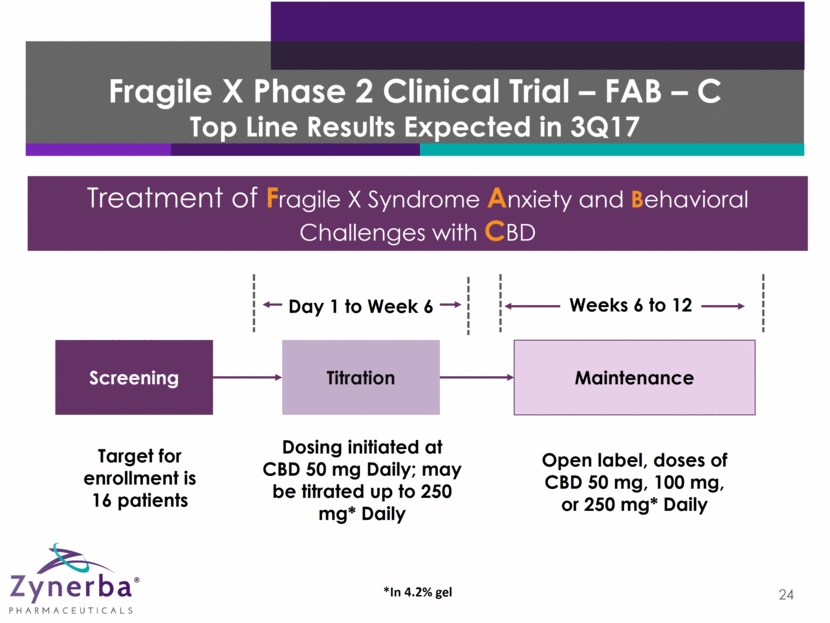
FAB – C Outcome Measures 25 Changes in Anxiety, Depression and Mood vs. Baseline as Measured by the ADAMS Scale Secondary Outcome Measures Aberrant Behavior Checklist Visual Analog Scale (VAS) to Assess Hyperactivity / Impulsivity Quality of Sleep- Sleep onset, sleep time, nighttime awakenings Primary Outcome Measure
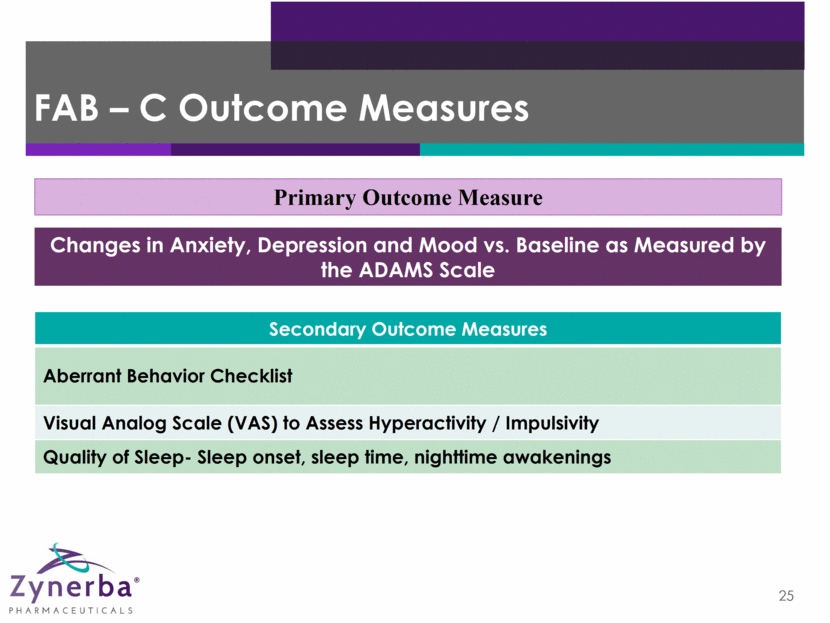
ZYN001 – THC Pro-Drug Patch 26 Patent-protected synthetic D-glyceric acid ester-Δ9-tetrahydrocannabinol in a transdermal patch Working with LTS Lohmann Therapie-Systeme AG to optimize the formulation of ZYN001 for use in a state of the art drug-adhesive matrix transdermal patch before initiating phase 1 trials ZYN001 is a pro-drug A drug administered in an inactive or less active form, designed to enable more effective delivery, and then converted into a different form through a normal metabolic process Unlike THC, ZYN001 is able to be efficiently absorbed into the skin through transdermal delivery After crossing the stratum corneum, ZYN001 is hydrolyzed to THC and glyceric acid under physiological conditions Structure & Conversion Delivery ZYN001
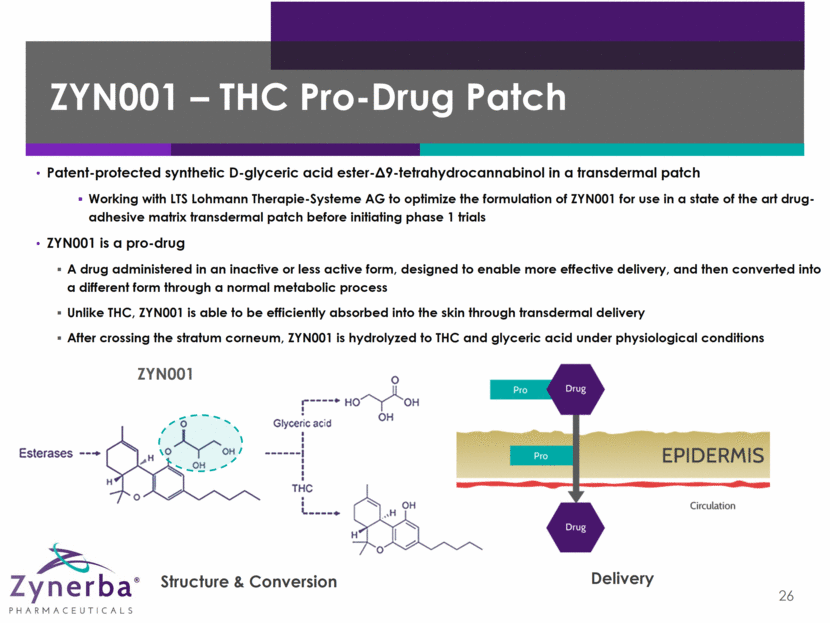
Note: Based upon FDA approved patch products. These results are not indicative of any preclinical or clinical data for ZYN001. Why a Patch? 27 Requirement Purpose Non-oral Avoids first-pass metabolism with increased bioavailability and more consistent plasma levels Controlled More consistent, controlled and sustained delivery No “peaks and valleys” as seen with oral Safe Improved safety profile with lower peak plasma levels Non-invasive Blood Level Time Max. Effective Level Min. Effective Level Oral Dosage Form Transdermal System Illustrative Controlled Delivery
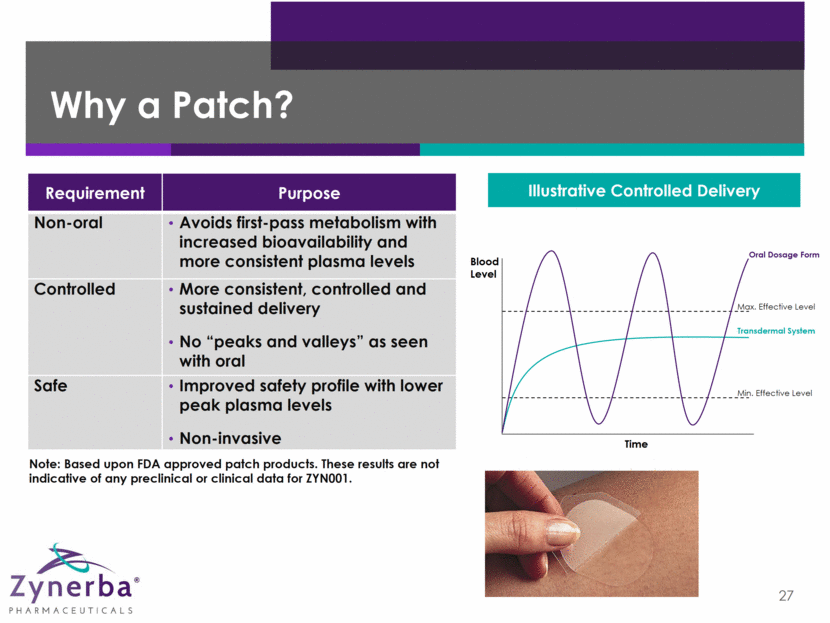
THC is a CB1 agonist Has an analgesic effect in chronic pain models Acts at many sites along pain transmission pathways Nabilone (THC analogue) in patients with fibromyalgia Third-party 4-week, randomized, double-blind, placebo-controlled trial (N=40) — significant decreases in pain scores on multiple instruments Third-party randomized, double-blind, active-controlled cross-over study in patients with coexisting chronic insomnia (N=29) Nabilone and amitriptyline x 2 weeks with a 2-week washout Nabilone was superior to amitriptyline in sleep quality ~6 million patients suffer from Fibromyalgia in the US* Why THC in Fibromyalgia? 28 * Data per Decision Resources
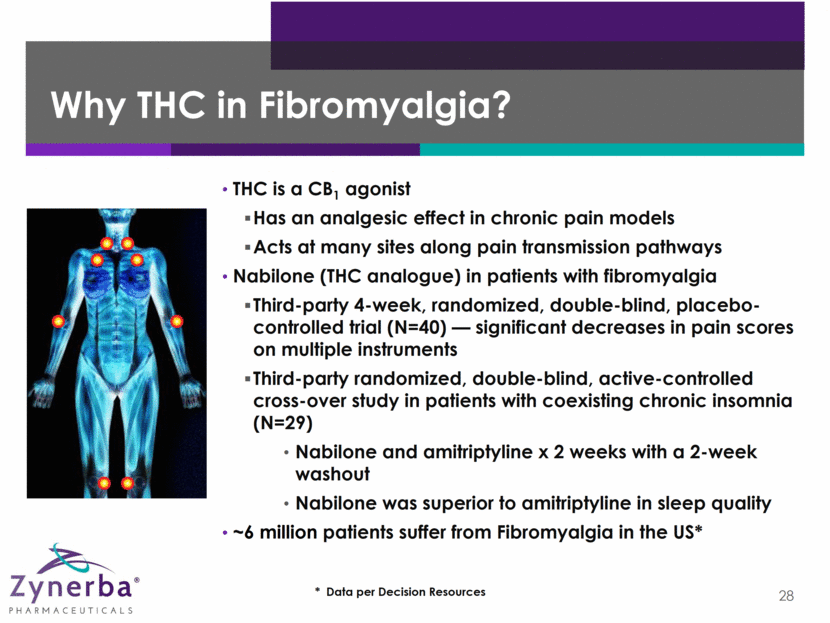
THC’s agonist effect on CB1 receptors modulates nociceptive thresholds by regulating neuronal activity Third-party randomized, double-blind, placebo-controlled crossover trial in diabetic peripheral neuropathy (DPN) demonstrated that THC is effective in reducing neuropathic pain 16 patients with DPN received low (1% THC), medium (4% THC) or high (7% THC) dose of vaporized Cannabis and placebo in randomized crossover design Pain scores, cognitive effects and tolerability were assessed All THC doses were significantly better than placebo in reducing spontaneous pain The high dose THC impaired performance on 2 of 3 neuropsychological tests Analysis of THC plasma concentration showed that levels <15 ng/ml correlated with pain relief but levels >15 ng/ml showed no correlation. Several third-party placebo-controlled trials of vaporized cannabis, smoked cannabis and cannabis via an inhaler have demonstrated efficacy in peripheral neuropathic pain ~15 million patients suffer from peripheral neuropathic pain in the US* Why THC in Peripheral Neuropathic Pain? 29 * Data per Decision Resources
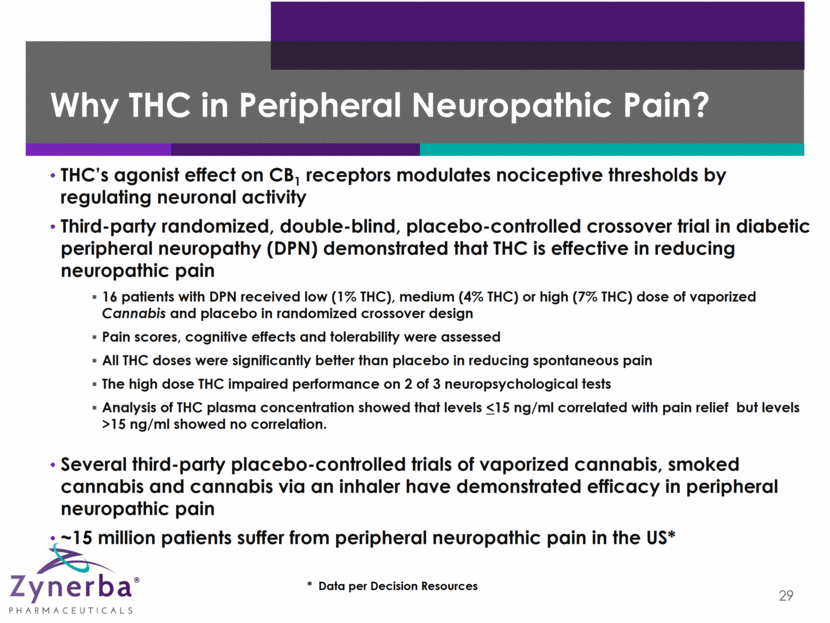
ZYN001 – THC Pro-Drug Patch Preliminary Phase 1 Clinical Plan 30 Trial Patients Dosing PD Evaluations Timing Single Rising Dose Trial in Normal Subjects Pharmacokinetic profile and tolerability evaluation 32 healthy volunteers and 12 patients with fibromyalgia Single dose Cognition and attention (Trail Making, PASAT and Divided Attention); mood (PANAS); subjective drug effects (ACRI) Trial initiation expected 1H2017 Multiple Rising Dose Trial in Normal Subjects and Patients with Fibromyalgia Multi-dose pharmacokinetic/ pharmacodynamic profile and tolerability evaluation 16 healthy volunteers and 12 patients with fibromyalgia Dosing for fourteen days Capsaicin, UV-B and Cold Pressor pain models; cognition and attention (Trail Making, PASAT and Divided Attention); mood (PANAS); subjective drug effects (ACRI) Trial initiation expected 1H2017 Bioequivalence Trial Evaluation of different application sites – upper arm vs. thigh vs. back 24 healthy volunteers Single dose Bioequivalence at arm, thigh and back Trial initiation expected in 2017 Note: Subject to change due to further regulatory, clinical and other considerations.
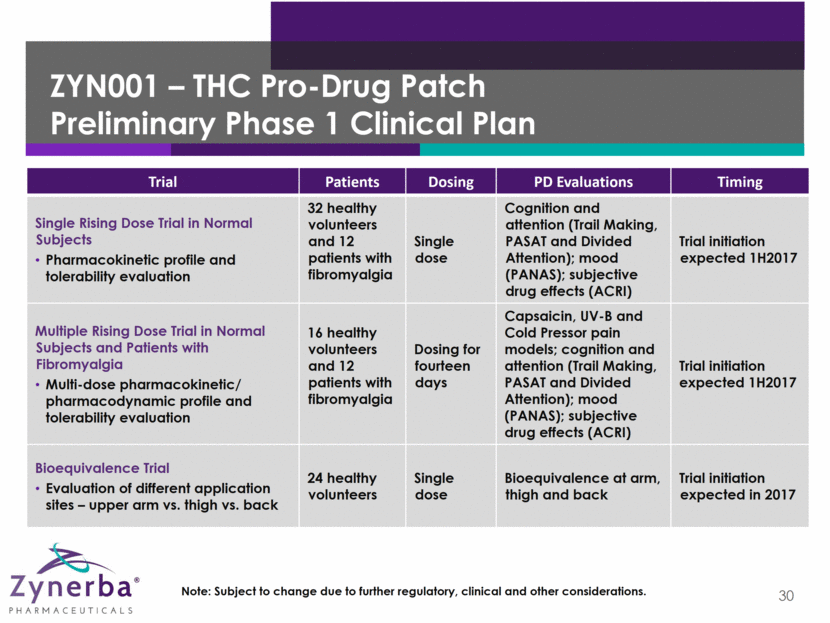
31 Note: Subject to change due to further regulatory, clinical and other considerations. Trial Patients Dosing Primary Endpoint Timing Efficacy and Tolerability in Patients with Fibromyalgia Double-blind, placebo-controlled 120 patients 12 weeks Change from baseline in Fibromyalgia Impact Questionnaire (FIQ) total score Trial initiation expected 2H2017 Efficacy and Tolerability in Patients with Peripheral Neuropathic Pain Double-blind, placebo-controlled 120 patients 12 weeks Visual Analog Scale for pain intensity Trial initiation expected 2H2017 ZYN001 – THC Pro-Drug Patch Preliminary Phase 2 Clinical Plan
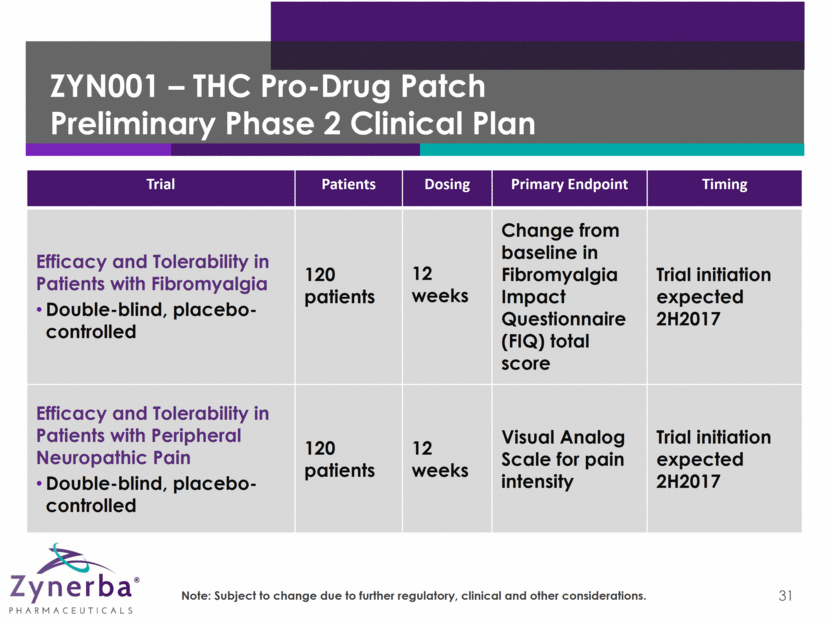
32 Cash & cash equivalents at 12/31/2016 was $31.0 million Raised $54.3 million in net proceeds from the sale and issuance of 3.2 million common shares through secondary offering at $18.00 per share in 1Q17 Cash at 12/31/2016 plus net proceeds from Q1 raise totals $85.3 million We believe that cash is sufficient to develop five Phase 3 ready programs and, assuming feedback from the FDA supports a decision to move forward, initiate at least one Phase 3 program and fund operations and capital requirements into 2019 Total shares outstanding at April 17, 2017 was 13,249,799 shares Strong Balance Sheet Provides Expected Runway into 2019
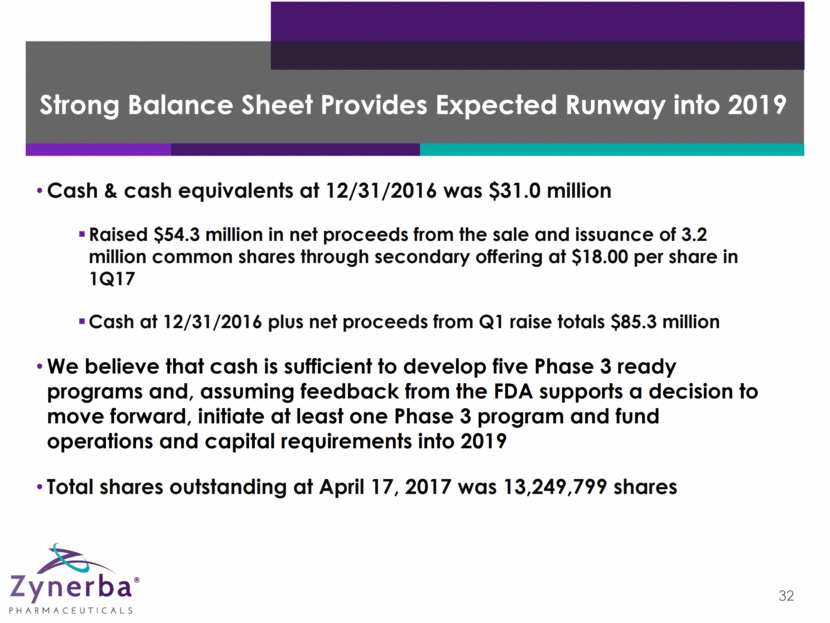
Why Zynerba is a Compelling Investment Opportunity in the High-Growth Cannabinoid Space 33 We believe CBD gel for focal seizures is a significantly de-risked lead candidate Reliable animal models show efficacy of CBD in epilepsy Third party studies have shown activity of CBD in reducing focal seizures STAR 1 trial is well powered to show clinical benefit versus placebo Zynerba’s transdermal approach has significant benefits Patent protection Synthetic manufacturing process can be scaled for large volume markets Attractive COGS and no royalty obligations should result in high gross margins Consistent, controlled blood levels of drug and potentially a better safety profile than oral formulations Focused on valuable unmet medical need markets ~ 1.5 million adult epilepsy patients in the US with focal seizures; ~ 31 million OA patients; ~ 6 million Fibromyalgia patients; ~15 million PNP patients and Orphan designation for Fragile X Syndrome* Significant clinical progress anticipated in the near term * Data per Decision Resources, Data Monitor and The Fragile X Society
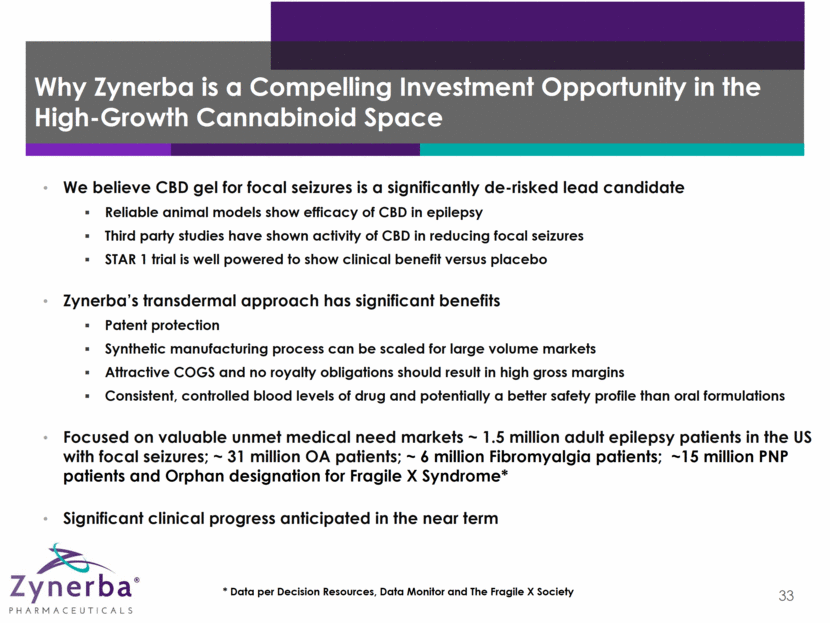
Proven Leadership in Transdermal Drug Development 34 Armando Anido Chairman of the Board & Chief Executive Officer Terri Sebree President Jim Fickenscher CFO & VP Corp. Development Suzanne Hanlon General Counsel and VP, Human Resources Brian Rosenberger VP, Commercial Donna Gutterman, PharmD VP, Medical Nancy Tich, PhD VP, Clinical
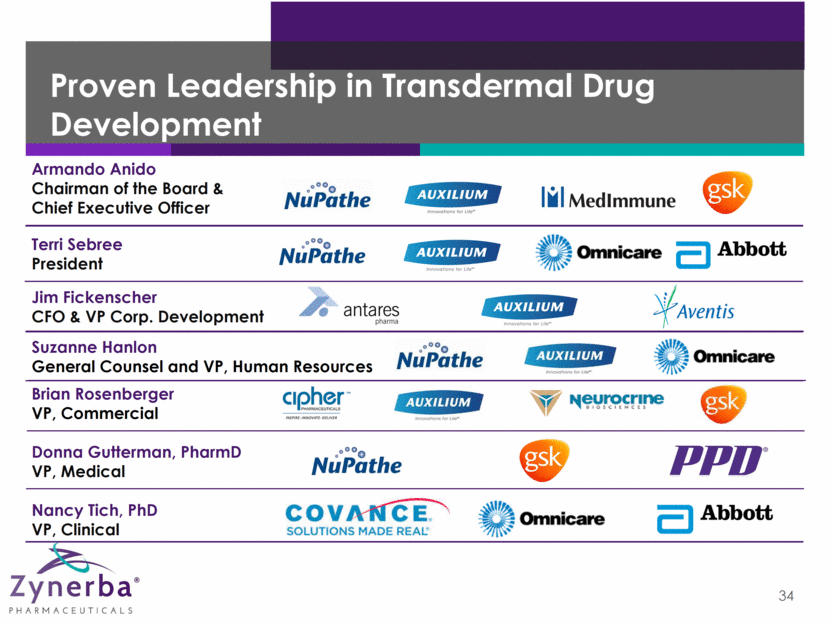
Jacqueline French, MD Professor of Neurology, NYU Langone Medical Center John Messenheimer, MD Consultant, Neurologist/Epileptologist, John Messenheimer PLLC Michael Rogawski, MD, PhD Professor of Neurology, UC Davis Center for Neuroscience Rodney Radtke, MD Professor of Neurology, Duke University Medical Center Randi J. Hagerman, MD Medical Director, UC Davis MIND Institute, Distinguished Professor, Endowed Chair in Fragile X Research, Department of Pediatrics, UC Davis School of Medicine Steven J. Siegel, MD, PhD Chair, Department of Psychiatry and Behavioral Sciences, Keck School of Medicine, University of Southern California Nicole Tartaglia, MD Associate Professor, Pediatrics-Developmental Pediatrics, University of Colorado Denver School of Medicine / Children’s Hospital of Colorado Daniel Clauw, MD Professor of Anesthesiology, Medicine (Rheumatology) & Psychiatry, University of Michigan Philip Mease, MD Clinical Professor, University of Washington, Seattle; Director of Rheumatology Research, Swedish Medical Center Lesley Arnold, MD Professor of Psychiatry and Behavioral Neuroscience, University of Cincinnati Steven P. Cohen, MD Professor Anesthesiology & Critical Care Medicine, Johns Hopkins School of Medicine Mark Wallace, MD Chair, Division of Pain Medicine, University of California San Diego Scientific Advisory Board 35 Epilepsy Fragile X Syndrome Osteoarthritis and Fibromyalgia Pain
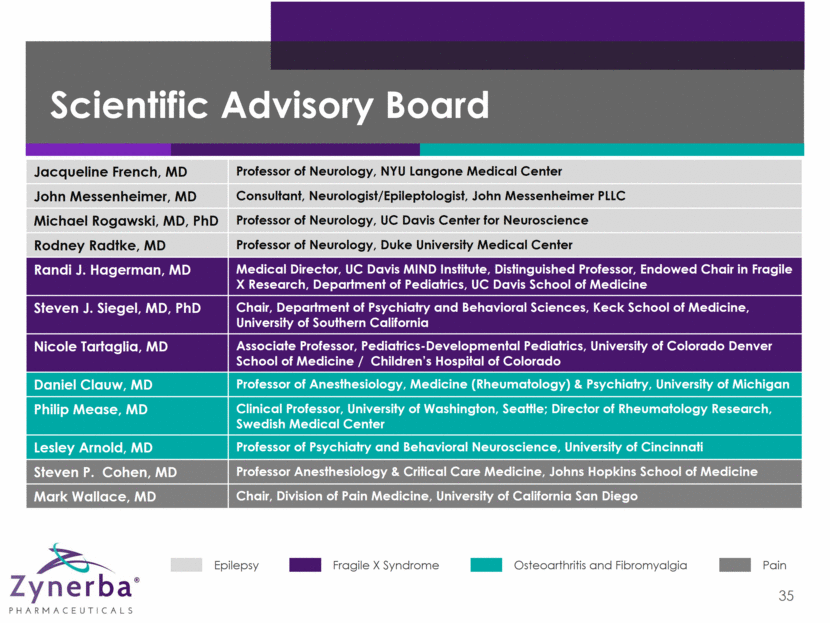
Investor Relations 36 NASDAQ: ZYNE Analyst Coverage* Jefferies: Biren Amin, PhD Piper Jaffray: Charles C. Duncan, PhD Oppenheimer: Derek Archila H.C. Wainwright: Corey Davis, PhD Roth: Michael Higgins Canaccord Genuity: Arlinda Lee, PhD Cantor Fitzgerald: Elemer Piros, PhD Maxim: Lauren Chung, PhD * Note: Any opinions, estimates or forecasts regarding Zynerba Pharmaceuticals, Inc.’s performance made by these analysts are theirs alone and do not represent opinions, forecasts or predictions of Zynerba Pharmaceuticals, Inc. or its management. Zynerba Pharmaceuticals, Inc. does not by its reference above imply its endorsement of or concurrence with such information, conclusions or recommendations. 484.581.7505 investorrelations@zynerba.com www.zynerba.com @ZynerbaPharma Zynerba Zynerba Investor Contact Jim Fickenscher, CFO and VP Corporate Development 484.581.7483 Argot Partners Investor Contact Kimberly Minarovich 212.600.1902

May 2017 A clinical-stage specialty pharmaceutical company dedicated to the development and commercialization of innovative transdermal synthetic cannabinoid treatments for patients with high unmet medical needs
